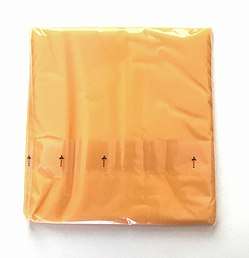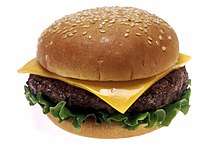American cheese
Modern American cheese is a type of processed cheese made from cheddar, colby, or similar cheeses. It is mild with a creamy and salty flavor, has a medium-firm consistency, and has a low melting point. It can be yellow/orange or white in color; yellow American cheese is seasoned and colored with annatto or paprika. It originated in the 1910s and is a common staple in many American dishes.

History
British colonists made cheddar cheese soon after their arrival in North America. By 1790, American-made cheddars were being exported back to England. According to Robert Carlton Brown, author of The Complete Book of Cheese, "The English called our imitation Yankee, or American, Cheddar, while here at home it was popularly known as yellow or store cheese".[1]
The Oxford English Dictionary lists the first known usage of "American cheese" as occurring in the Frankfort, Kentucky, newspaper The Guardian of Freedom in 1804. The next usage given is in 1860 by Charles Dickens in his series The Uncommercial Traveller.[2]
In 1878, the total export of American cheese was 355 million pounds per year, with an expected growth to 1,420 million pounds.[3]

After patenting a new method for manufacturing processed cheese in 1916,[4][5] James L. Kraft began marketing it in the late 1910s, and the term "American cheese" rapidly began to refer to the processed variety instead of the traditional but more expensive cheddars also made and sold in the US.
Legal definition
According to the US Standards of Identity for Dairy Products, part of the Code of Federal Regulations (CFR), to be labeled "American cheese" a processed cheese is required to be manufactured from cheddar cheese, colby cheese, washed curd cheese, or granular cheese, or any mixture of two or more of these.[6] The CFR also includes regulations for the manufacturing of processed American cheese.[7][8]
Because its manufacturing process differs from traditional cheeses,[9] federal laws mandate that it be labeled as "processed American cheese" if made from combining more than one cheese,[10] or "processed American cheese food" if dairy ingredients such as cream, milk, skim milk, buttermilk, cheese whey, or albumin from cheese whey are added.[11]
Manufacturing process
Traditional cheese is ground, combined with emulsifying agents and other ingredients, mixed and heated until it forms a "melted homogeneous" mixture.[10] To pasteurize it, the cheese mixture must be heated to a temperature of at least 150 °F (66 °C) for a minimum of 30 seconds.[10] Composition requirements of processed American cheese control the percentage of milkfat, moisture, salt and pH value in the final product, along with specifications for flavor, body and texture, color, and meltability.[12]
Processed American cheese is packaged in individually wrapped slices, as unwrapped slices sold in stacks, or in unsliced blocks.[13] Individually wrapped slices are formed from processed cheese which solidifies only between the wrapping medium; these slices, sold as "singles", are typically the least like traditional cheese. Blocks of American cheese are more similar to traditional cheese, and are sliced to order at deli counters.
Market size
Americans purchased about $2.77 billion worth of American cheese in 2018, but the popularity was falling, and, according to Bloomberg News, sales were projected to drop 1.6% in 2018. The average price for a pound of American was below $4 for the first time since 2011.[14]
Notes
- Robert Carlton Brown, The Complete Book of Cheese (New York: Programmer Publishing Company, 1955). Republished in 2006: "Bob" Brown, The Complete Book of Cheese (Echo Library, 2006).
- Edited by Edmund Whiner and John Simpson. (1991), Oxford English Dictionary, I (Second ed.), Oxford, UK: Oxford University Press, p. 397, ISBN 0-19-861258-3CS1 maint: extra text: authors list (link)
- "The Cheese All Inspected", The New York Times, p. 5, December 8, 1878
- "Emmi Gerber – Über Gerber". Emmi Fondue AG. Archived from the original on May 31, 2013. Retrieved March 26, 2013.
- "Kraft Foods Corporate Timeline" (PDF). Kraft Foods Group, Inc. Retrieved March 26, 2013.
- US Code of Federal Regulations Title 21 (Food and Drugs), Subchapter B, Part 133, Section 169-173 (Pasteurized processed cheese), the allowed usage of the term "American cheese" for certain types of "Pasteurized processed cheese" is detailed.U.S. Food and Drug Administration (April 1, 1999), Title 21, Subchapter B, Part 133, U.S. Government Printing Office, Paragraph (e)(2)(ii) of section 133.169, archived from the original on February 17, 2007, retrieved February 17, 2007,
In case it is made of cheddar cheese, washed curd cheese, colby cheese, or granular cheese or any mixture of two or more of these, it may be designated "Pasteurized processed American cheese"; or when cheddar cheese, washed curd cheese, Colby cheese, granular cheese, or any mixture of two or more of these is combined with other varieties of cheese in the cheese ingredient, any of such cheeses or such mixture may be designated as "American cheese."
- Carić, M.; Kaláb, M. (1993). Fox, P.F. (ed.). Cheese: Chemistry, physics and microbiology. Boston, MA: Springer. p. 467–505. doi:10.1007/978-1-4615-2800-5_15.
- Kapoor, Rohit; Metzger, Lloyd E. (March 2008). "Process Cheese: Scientific and Technological Aspects—A Review". Comprehensive Reviews in Food Science and Food Safety. 7 (2): 194–214. doi:10.1111/j.1541-4337.2008.00040.x.
- "Standards of Identity for Dairy Products". MilkFacts.info. Retrieved February 25, 2013.
- "CFR- Code of Federal Regulations Title 21: Sec. 133.169 Pasteurized Process Cheese". Electronic Code of Federal Regualtions. U.S. Food and Drug Administration.
- "CFR – Code of Federal Regulations Title 21: Sec. 133.173 Pasteurized process cheese food". U.S. Food and Drug Administration.
- "USDA commodity requirements document: DPPC3 Pastuerized process American cheese for use in domestic programs" (PDF). United States Department of Agriculture. United States Department of Agriculture. 2013. Retrieved March 29, 2019.
- Tamine, A. Y. (2011). Processed cheese and analogues (Vol. 16). John Wiley & Sons. p. 14. doi:10.1111/j.1541-4337.2008.00040.x.
- Mulvany, Lydia; Patton, Leslie (October 10, 2018). "Millennials Kill Again. The Latest Victim? American Cheese". Retrieved October 11, 2018.
External links
| Wikimedia Commons has media related to American cheese. |
- Making American cheese on the farm for home consumption, Farmers' Bulletin No. 1734, U.S. Department of Agriculture, October 1934. Hosted at University of North Texas Government Documents Department.
- An American-type cheese: how to make it for home use, Farmers' Bulletin No. 2075, U.S. Department of Agriculture, October 1954.
